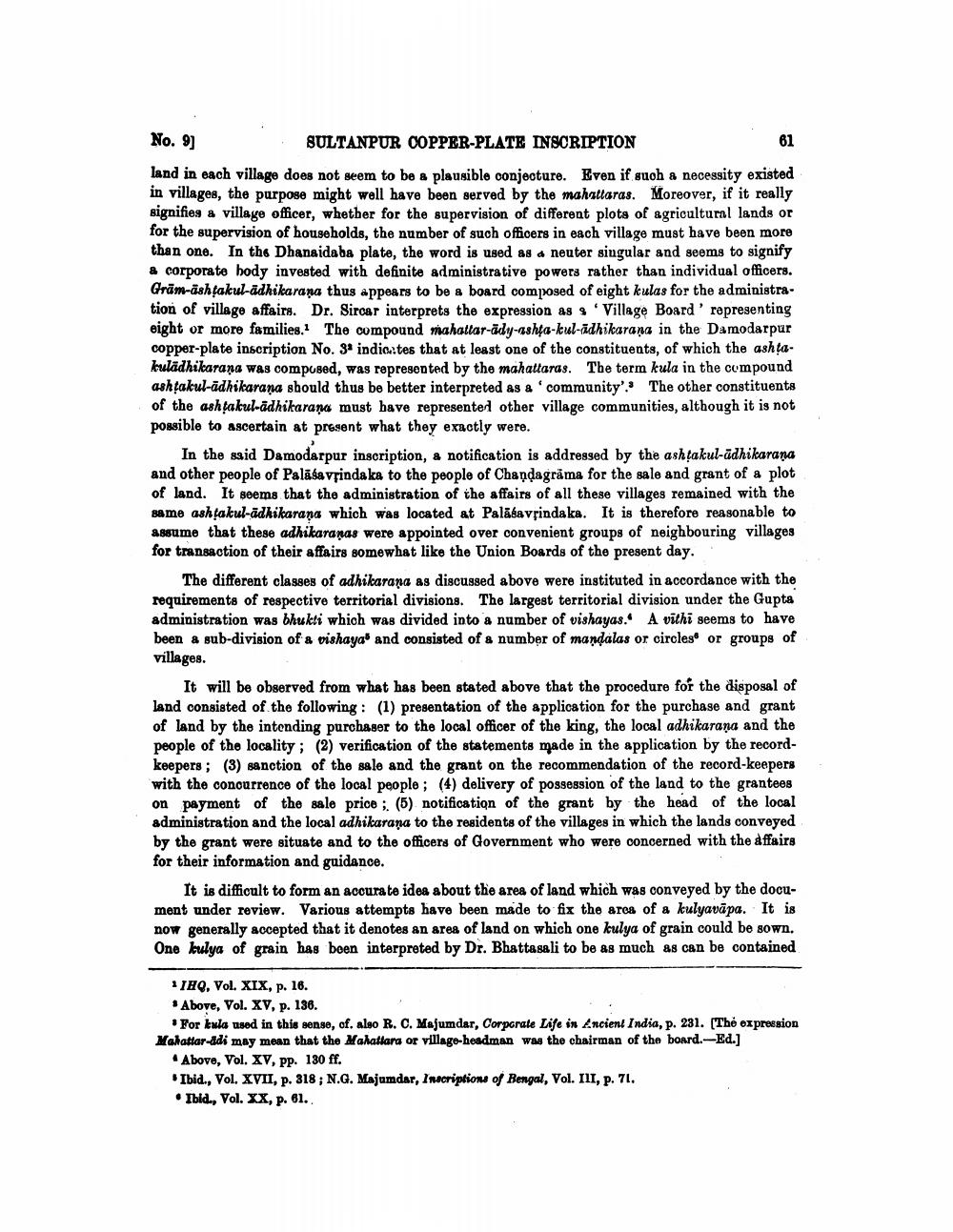________________
No. 9] SULTANPUR COPPER-PLATE INSCRIPTION
61 land in each village does not seem to be a plausible conjecture. Even if such a necessity existed in villages, the purpose might well have been served by the mahattaras. Moreover, if it really signifies a village officer, whether for the supervision of different plots of agricultural lands or for the supervision of households, the number of such officers in each village must have been more than one. In the Dhanaidaba plate, the word is used as a neuter singular and seems to signify & corporate body invested with definite administrative powers rather than individual officers. Grām-ashtakul-adhikarana thus appears to be a board composed of eight kulas for the administration of village affairs. Dr. Sircar interprets the expression as : Village Board' representing eight or more families. The compound mahattar-ädy-ashta-kul-adhikaraṇa in the Damodarpur copper-plate inscription No. 3 indio..tes that at least one of the constituents, of which the ashtakulādhikaraṇa was composed, was represented by the mahattaras. The term kula in the compound ashtakul-adhikarana should thus be better interpreted as a community': The other constituents of the ashtakul-adhikarana must have representer other village communities, although it is not possible to ascertain at present what they exactly were.
In the said Damodarpur inscription, & notification is addressed by the ashtakul-adhikarana and other people of Paläsa vrinda ka to the people of Chandagrama for the sale and grant of a plot of land. It seems that the administration of the affairs of all these villages remained with the same ashtakul-adhikarana which was located at Palādavrindaka. It is therefore reasonable to assume that these adhikaranas were appointed over convenient groups of neighbouring villages for transaction of their affairs somewhat like the Union Boards of the present day.
The different classes of adhikarana as discussed above were instituted in accordance with the requirements of respective territorial divisions. The largest territorial division under the Gupta administration was bhukti which was divided into a number of vishayas. A vithi seems to have been a sub-division of a vishayas and consisted of a number of mandalas or circles or groups of villages.
It will be observed from what has been stated above that the procedure for the disposal of land consisted of the following: (1) presentation of the application for the purchase and grant of land by the intending purchaser to the local officer of the king, the local adhikarana and the people of the locality ; (2) verification of the statements made in the application by the recordkeepers ; (3) sanction of the sale and the grant on the recommendation of the record-keepers with the concurrence of the local people; (4) delivery of possession of the land to the grantees on payment of the sale price ; (5) notification of the grant by the head of the local administration and the local adhikarana to the residents of the villages in which the lands conveyed by the grant were situate and to the officers of Government who were concerned with the affairs for their information and guidance.
It is difficult to form an accurate idea about the area of land which was conveyed by the document under review. Various attempts have been made to fix the area of a kulyavāpa. It is now generally accepted that it denotes an area of land on which one kulya of grain could be sown. One hulya of grain has boen interpreted by Dr. Bhattasali to be as much as can be contained
11HQ, Vol. XIX, p. 16. . Above, Vol. XV, p. 136.
For kula used in this sonse, of, also R. C. Majumdar, Corporate Life in Ancient India, p. 231. (Thé expression Mahattar-ddi may mean that the Mahattara or village-headman was the chairman of the board. -Ed.] • Above, Vol. XV, PP. 130 ff.
Ibid., Vol. XVII, p. 318 ; N.G. Majumdar, Inscriptions of Bengal, Vol. III, p. 71, • Ibid., Vol. XX, p. 61.




